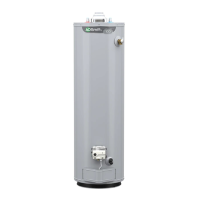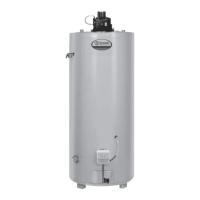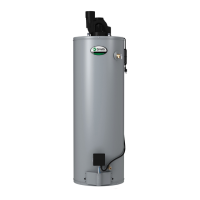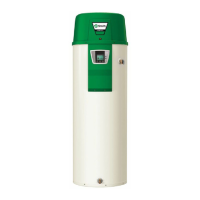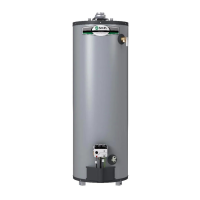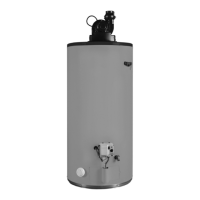Do you have a question about the A.O. Smith GVR300 and is the answer not in the manual?
Safety warnings regarding fire and explosion risks from various hazards.
Warnings about water temperature and potential scalding risks.
Risks associated with carbon monoxide gas and proper ventilation.
Cautionary notes on installation and usage leading to property damage.
Details on the gas control valve and its components.
Information on required gas pressures for operation.
Guidelines for adjusting water temperature settings.
Explanation of the combustion chamber and thermal cut-off switch.
Step-by-step instructions for lighting the pilot.
Troubleshooting steps when the status light doesn't blink.
Troubleshooting steps when the pilot fails to ignite.
Troubleshooting pilot ignition issues when status light is abnormal.
Explanation of various status light flash codes and their meanings.
Safety warning regarding flammable vapors around the unit.
Procedure to test the venting system draft.
Checking electrical and gas connections for issues.
Methods for checking gas supply and manifold pressures.
Testing thermopile voltage without the pilot lit.
Testing thermopile voltage with the pilot lit.
Safety warning about flammable vapors near the unit.
Troubleshooting steps for lack of hot water.
Identifying causes for insufficient hot water supply.
Explains issues with colder incoming water.
Diagnosing issues with fixture control valves.
Adjusting thermostat settings for adequate hot water.
Addressing increased demand for hot water.
Identifying if the water heater capacity is insufficient.
Correcting reversed hot/cold water line connections.
Checking for plumbing leaks affecting hot water.
Addressing sediment accumulation in the tank.
Explains water condensation issues and potential causes.
Troubleshooting leaks at plumbing connections.
Diagnosing drips from the T&P relief valve.
Adjusting settings when water temperature is excessive.
Troubleshooting low pressure on hot water lines.
Addressing odors in hot water.
Step-by-step removal of the manifold and burner.
Procedures for separating the burner from the manifold.
Instructions for replacing the pilot and thermopile.
Guide for installing a new pilot/thermopile assembly.
Maintenance of the base-ring filter.
Procedures for cleaning the combustion chamber and flame arrestor.
Reassembly steps for the manifold/burner assembly.
How to test the igniter's functionality.
Steps for removing and installing the gas control valve.
Recommended procedures for draining and flushing the tank.
How to assess air requirements for combustion and ventilation.
Method for calculating room volume for air supply.
Determining the necessary air volume for appliances.
Verifying sufficient combustion and ventilation air.
Guidelines for installing ventilation with outside air.
Different types of ventilation methods available.
Calculating required vent opening sizes.
Formulas for calculating vent opening and duct sizes.
Special considerations for water heater installation in attics.
Impact of high attic temperatures on water heater operation.
Addressing inadequate air supply for combustion.
Checking for blocked air screens and flame arrestors.
Ensuring correct venting installation and function.
How decompression can affect pilot outage.
Wind effects on attic installations and flue draft.
Preventing and mitigating water damage from leaks.
Causes and remedies for elevated water temperatures.
Instructions for connecting draft hoods to vent pipes.
List of tools and materials for draft hood installation.
Overview of different draft hood types discussed.
Types of vent pipes discussed in the section.
Steps for installing draft hoods and vent pipes.
Guidance on connecting different vent pipe types.
Specific connectors for Type B vent pipes.
Safety warnings regarding fire and explosion risks from various hazards.
Warnings about water temperature and potential scalding risks.
Risks associated with carbon monoxide gas and proper ventilation.
Cautionary notes on installation and usage leading to property damage.
Details on the gas control valve and its components.
Information on required gas pressures for operation.
Guidelines for adjusting water temperature settings.
Explanation of the combustion chamber and thermal cut-off switch.
Step-by-step instructions for lighting the pilot.
Troubleshooting steps when the status light doesn't blink.
Troubleshooting steps when the pilot fails to ignite.
Troubleshooting pilot ignition issues when status light is abnormal.
Explanation of various status light flash codes and their meanings.
Safety warning regarding flammable vapors around the unit.
Procedure to test the venting system draft.
Checking electrical and gas connections for issues.
Methods for checking gas supply and manifold pressures.
Testing thermopile voltage without the pilot lit.
Testing thermopile voltage with the pilot lit.
Safety warning about flammable vapors near the unit.
Troubleshooting steps for lack of hot water.
Identifying causes for insufficient hot water supply.
Explains issues with colder incoming water.
Diagnosing issues with fixture control valves.
Adjusting thermostat settings for adequate hot water.
Addressing increased demand for hot water.
Identifying if the water heater capacity is insufficient.
Correcting reversed hot/cold water line connections.
Checking for plumbing leaks affecting hot water.
Addressing sediment accumulation in the tank.
Explains water condensation issues and potential causes.
Troubleshooting leaks at plumbing connections.
Diagnosing drips from the T&P relief valve.
Adjusting settings when water temperature is excessive.
Troubleshooting low pressure on hot water lines.
Addressing odors in hot water.
Step-by-step removal of the manifold and burner.
Procedures for separating the burner from the manifold.
Instructions for replacing the pilot and thermopile.
Guide for installing a new pilot/thermopile assembly.
Maintenance of the base-ring filter.
Procedures for cleaning the combustion chamber and flame arrestor.
Reassembly steps for the manifold/burner assembly.
How to test the igniter's functionality.
Steps for removing and installing the gas control valve.
Recommended procedures for draining and flushing the tank.
How to assess air requirements for combustion and ventilation.
Method for calculating room volume for air supply.
Determining the necessary air volume for appliances.
Verifying sufficient combustion and ventilation air.
Guidelines for installing ventilation with outside air.
Different types of ventilation methods available.
Calculating required vent opening sizes.
Formulas for calculating vent opening and duct sizes.
Special considerations for water heater installation in attics.
Impact of high attic temperatures on water heater operation.
Addressing inadequate air supply for combustion.
Checking for blocked air screens and flame arrestors.
Ensuring correct venting installation and function.
How decompression can affect pilot outage.
Wind effects on attic installations and flue draft.
Preventing and mitigating water damage from leaks.
Causes and remedies for elevated water temperatures.
Instructions for connecting draft hoods to vent pipes.
List of tools and materials for draft hood installation.
Overview of different draft hood types discussed.
Types of vent pipes discussed in the section.
Steps for installing draft hoods and vent pipes.
Guidance on connecting different vent pipe types.
Specific connectors for Type B vent pipes.
| Model | GVR300 |
|---|---|
| Capacity | 30 gallons |
| Power Source | Natural Gas |
| Warranty | 6 years |
| Diameter | 20 inches |
| Type | Gas |
| Dimensions | 49 x 20 inches |


